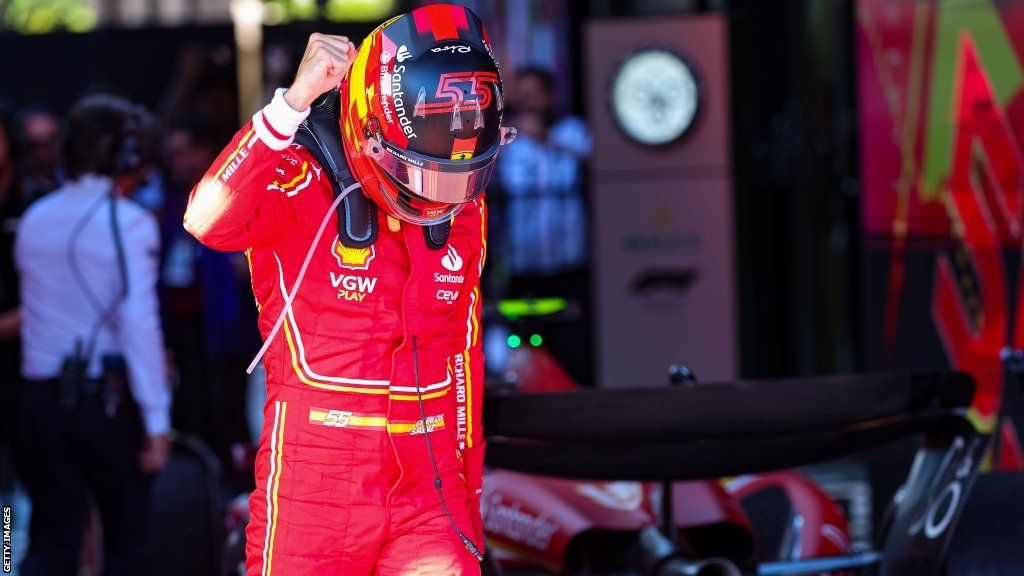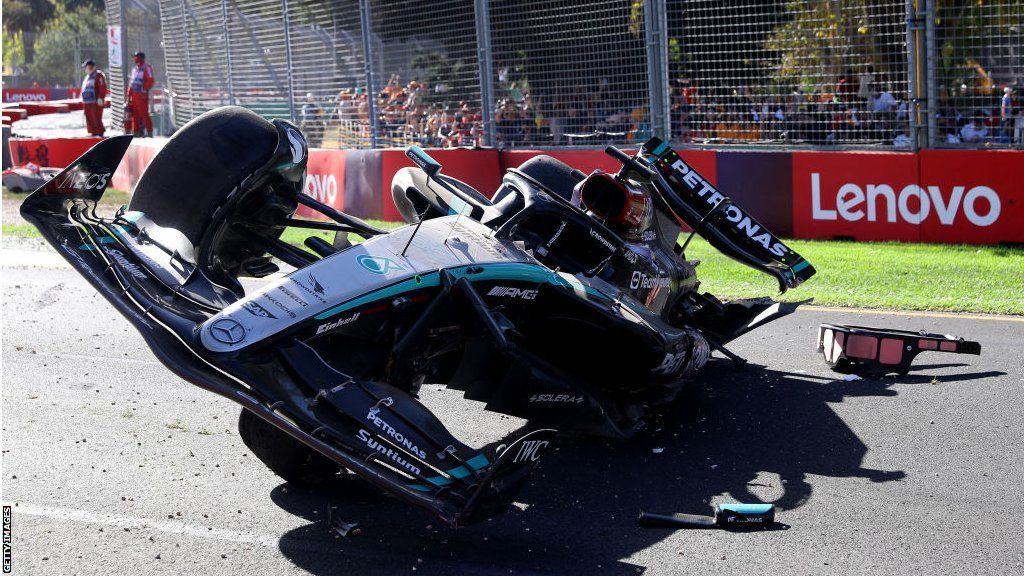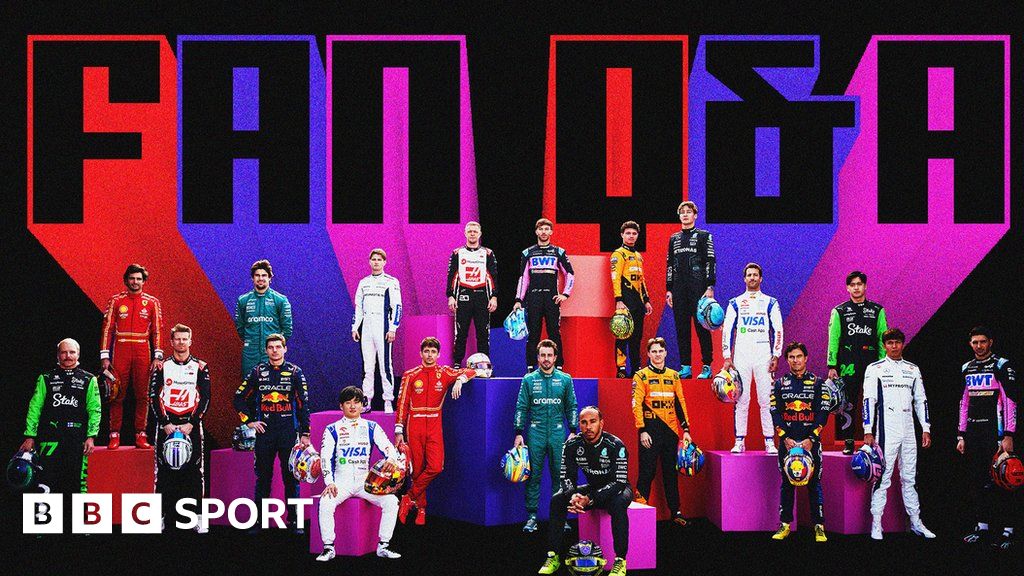
There was plenty of drama at the Australian Grand Prix as Carlos Sainz led Charles Leclerc to a Ferrari one-two in Melbourne on Sunday.
Max Verstappen and Lewis Hamilton had to retire their cars and Mercedes’ issues continued after George Russell crashed in the final lap of the race.
There is plenty to talk about before the Japanese Grand Prix from 5-7 April, and BBC Sport F1 correspondent Andrew Benson has all the answers to your questions.
Tyre degradation and management. Do you think it would be better to have multiple tyre suppliers again in F1?
Andrew: It’s not for me to say what the F1 rules should be, but I can tell you that there is no appetite among F1 stakeholders for a ‘tyre war’, as it is known when there is more than one tyre supplier in competition.
But to address the central issue in the question – ie tyre degradation and management – it does not require multiple suppliers to stop those being such an issue as they are now.
The Pirelli tyres supplied to F1 are most unlike what might be called a typical racing tyre, in that they are very thermally sensitive, and typically require gentle treatment to prevent them overheating. If they become too hot, then the grip never tends to come back.
This means drivers can hardly ever – even on qualifying laps – push to the limit. This is a very abnormal situation – and was certainly not the case when predecessors Michelin, Bridgestone and Goodyear were in F1 in the 1990s and 2000s, whether there was competition or not. And it’s not how the tyres behave in other categories where Pirelli is not the supplier, for example in endurance racing or IndyCars.
Pirelli has repeatedly been asked in recent years to stop the tyres behaving in this way, and in addition to widen their working temperature window as well as to make the ‘extreme’ wet tyre better.
F1 had the opportunity to change tyre suppliers last year, when Bridgestone made a bid to return. Many people were pushing F1 chairman Stefano Domenicali to make the switch, but in the end he preferred to stick with Pirelli.
Where do you think Carlos Sainz will go in 2025?
Andrew: The driver market is unusually open this year. Yes, both seats at Ferrari and McLaren are full but Red Bull, Mercedes and Aston Martin all have at least one available, as do most of the teams in the back half of the grid, of which the most attractive long-term is Sauber, as it is morphing into Audi by 2026.
Sainz will be close to the top of most people’s lists – he is too good not to be. But his attractiveness is less than it might seem because of the other drivers in the picture – primarily Fernando Alonso and Andrea Kimi Antonelli.
You might think Sainz would be a good fit at Red Bull, Mercedes or Aston Martin, for example. And Audi – as Sauber will become in 2026 – are definitely interested.
But there were tensions between Red Bull, Max Verstappen and Sainz when they were team-mates at Toro Rosso.
Mercedes’ sights are set on Verstappen – should he become available, Antonelli – their protege in Formula 2 and then Alonso, in that order.
And Aston Martin want to keep Alonso, and have already offered him a lucrative new multi-year contract, and will only look elsewhere if he moves. So Sainz is to some degree a hostage of fortune. He’ll definitely end up somewhere, but it’s a very fluid situation and hard to predict as a result.

What future races can you see being added to the calendar? And could F1 rotate some of the events – Germany? South Africa?
Andrew: There is not much prospect at the moment of Germany or France returning to the calendar. Formula 1 came close to a deal with Kyalami in South Africa a couple of years ago but that prospect, too, has receded.
F1 definitely wants a race in Africa, but it is proving a difficult needle to thread. The new race in Madrid for 2026 has already been announced. And the USA is now full with the three races in Austin, Miami and Las Vegas.
As the calendar expands, rotation is definitely a topic on the agenda – between Belgium and the Netherlands, for example. But for now the calendar seems relatively stable. From time to time one hears of other countries being in the mix but there is nothing obvious coming in the near term.
Has the cost cap added to the problem of catching Red Bull for the other teams?
This is a really interesting question, to which I’m afraid it is difficult to give a definitive answer. On the one hand, the cost cap has prevented big teams spending their way out of problems by throwing money at them as they might have done in the past. So in that sense, you could say, yes, perhaps.
On the other hand, it has also reduced the budgets of the big teams – so it is also stopping Red Bull developing as much as they might otherwise have done. So you could argue in that sense that it has made no difference, or perhaps even helped keep Red Bull in some sort of check.
Are Aston Martin stuck in the middle of the field with little chance of improvement or do they have anything up their sleeves?
Andrew: Aston Martin have definitely slipped backwards since their remarkable start to last season, when they leapt from the midfield to close to the front and were, for the first third of the season, the second most competitive team.
After three races, on average qualifying pace, they are the fourth-fastest team in 2024 behind Red Bull, Ferrari and McLaren and just a smidge ahead of Mercedes. And that’s pretty much where they are in races, too.
There is an open question about Aston Martin at the moment. We know Mercedes are struggling with correlation between their wind tunnel and on-track performance – their car has less performance on track than their tools are saying it should have.
So, is there a problem with the Mercedes wind tunnel? And is this also affecting Aston Martin, who also use it while they are building their own brand new one? After all, they also got a bit lost last year as they tried to develop their car.
They say that they have set out this year with a development plan that will address the issues of last year and ensure they at least keep up with the teams around them. Time will tell.
Often strategy calls are largely based on predictions by computers. Do you think F1 is becoming a bit like chess between these computers?
Andrew: Strategy is very much led by computers – the teams have complex software that tracks the race and shows them live what might happen in the event of various choices. Ultimately, it is a human being who decides which of those choices to make.
So, if it’s a chess match, it’s one between people with the aid of computers, not between computers alone.
Let’s talk about Williams. How do you see their improvement and season going?
Andrew: Williams are definitely in a bit of a mess at the moment – but it is a mess founded in the desire to progress. New team principal James Vowles has been open about the fact that, in trying to bring the team up to date in terms of technology and working practices, he has pushed them beyond the limit over the winter.
The evidence of this was seen in Australia, when the fact Williams had not yet built a third chassis bit them hard. Alex Albon crashed heavily on Friday, and that left them with just one car. Vowles felt obliged to take Logan Sargeant out of it and give it to Albon as their faster driver.
Vowles says they will be exposed to this issue at the next race in Japan, as well.
As for progress, Albon admitted in Melbourne that the team had hoped to start this year in a more competitive position. Vowles is a smart guy with big ambitions and big ideas. But he needs time to turn around a team that is still suffering from the effects of close to two decades of under-investment
Why does Russell keep wilting under pressure in high-stake overtake attempts? What can he work on? Same happened in Singapore last year.

Andrew: Mmm. It feels a bit harsh to blame George Russell’s last-lap crash in Australia on him alone. After all, Fernando Alonso was penalised for “potential dangerous driving” in slowing for the corner, even down-shifting, and then accelerating again. Actions which caught Russell by surprise, understandably.
That is a very different situation from Singapore when, yes, he made a simple mistake, clipping a wall on the last lap, albeit just after Lando Norris did exactly the same right in front of him but not quite as heavily.
Surely this result in Australia is a good day for F1? Max Verstappen domination must be challenged to keep us in the wider audience remotely interested.
Andrew: Variations of this question have been coming up a lot since we started these Q&As, understandably. Of course, it’s true that if Verstappen and Red Bull continue to dominate, it is likely to have an effect on audience interest.
But F1 is a meritocracy. Put the best driver – as many in F1 believe Verstappen now to be – in the best car, and give all the others who are fast enough to at least give him a run for his money in less competitive machinery, and this is what happens.
It might not be pretty or entertaining to watch – and without doubt Carlos Sainz’s victory for Ferrari in Melbourne was most welcome for all neutrals. But it’s not Verstappen’s fault, nor Red Bull’s. It’s up to the others to catch up.

-
The health benefits of going to bed one hour earlier: Dr Michael Mosley investigates the positive effects of a bit more sleep
-
Welcome to the weird world of an NHS labour ward: Ben Whishaw stars in Adam Kay’s raw, ridiculous rollercoaster diary of a junior doctor’s life

